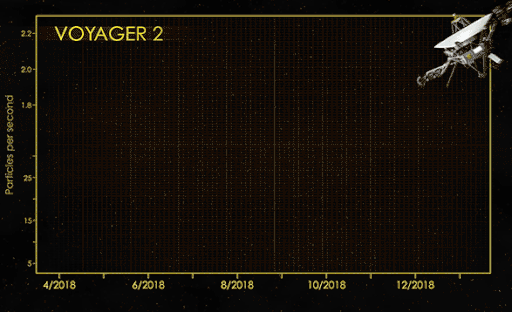VOYAGER 2 ENTERS INTERSTELLAR SPACE: Voyager 2 has exited the sun’s magnetic bubble and entered interstellar space. Mission scientists announced the breakthrough earlier today at the American Geophysical Unionmeeting in Washington DC. Its twin, Voyager 1, crossed the same boundary in 2012, but Voyager 2’s crossing is arguably more significant because it carries a working instrument that can sense interstellar plasmas, providing the first in situ sampling of matter between the stars.
The most compelling evidence of Voyager 2’s exit from the heliosphere came from its onboard Plasma Science Experiment (PLS), an instrument that stopped working on Voyager 1 in 1980. Until recently, Voyager 2 was surrounded mainly by the solar wind–a type of plasma flowing outward from the sun. On Nov. 5th, Voyager 2’s plasma instrument observed a sharp decline in the solar wind, and since that date, it has observed no solar wind flow–a clear sign that the probe has left the heliosphere.
Replacing the solar wind is a blizzard of galactic cosmic rays. The sun’s magnetic field substantially protects the solar system from cosmic rays, fending off the high energy debris of supernova explosions in the Milky Way and elsewhere. Now that Voyager 2 has exited that protective shell, it is baldly exposed to cosmic rays, and its cosmic ray subsystem is registering a surge.
Launched in 1977, Voyager 2 now is slightly more than 11 billion miles (18 billion kilometers) from Earth. Mission operators still can communicate with Voyager 2 as it enters this new phase of its journey, but information – moving at the speed of light – takes about 16.5 hours to travel from the spacecraft to Earth.
The Voyager probes are powered using heat from the decay of radioactive material, contained in a radioisotope thermal generator (RTG). The power output of the RTGs diminishes by about four watts per year, which means that various parts of the Voyagers, including the cameras on both spacecraft, have been turned off over time to manage power. Thanks to these precautions, the Voyagers could continue to send back at least some data for years to come.
“There is still a lot to learn about the region of interstellar space immediately beyond the heliosphere,” said Ed Stone, Voyager project scientist based at Caltech in Pasadena, California. Stay tuned for updates from the stars.



